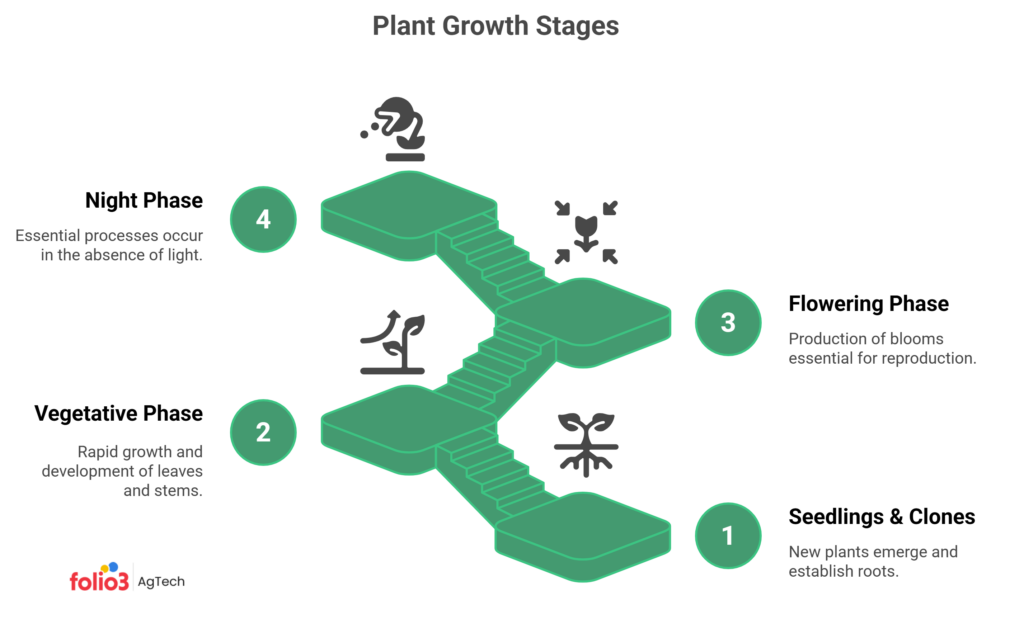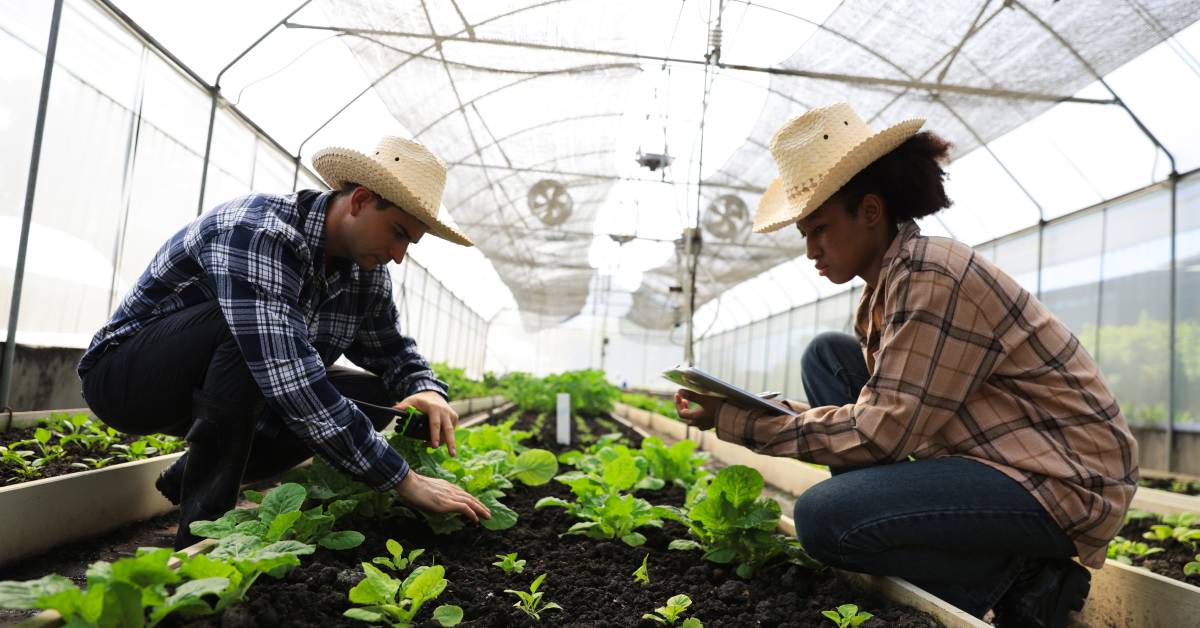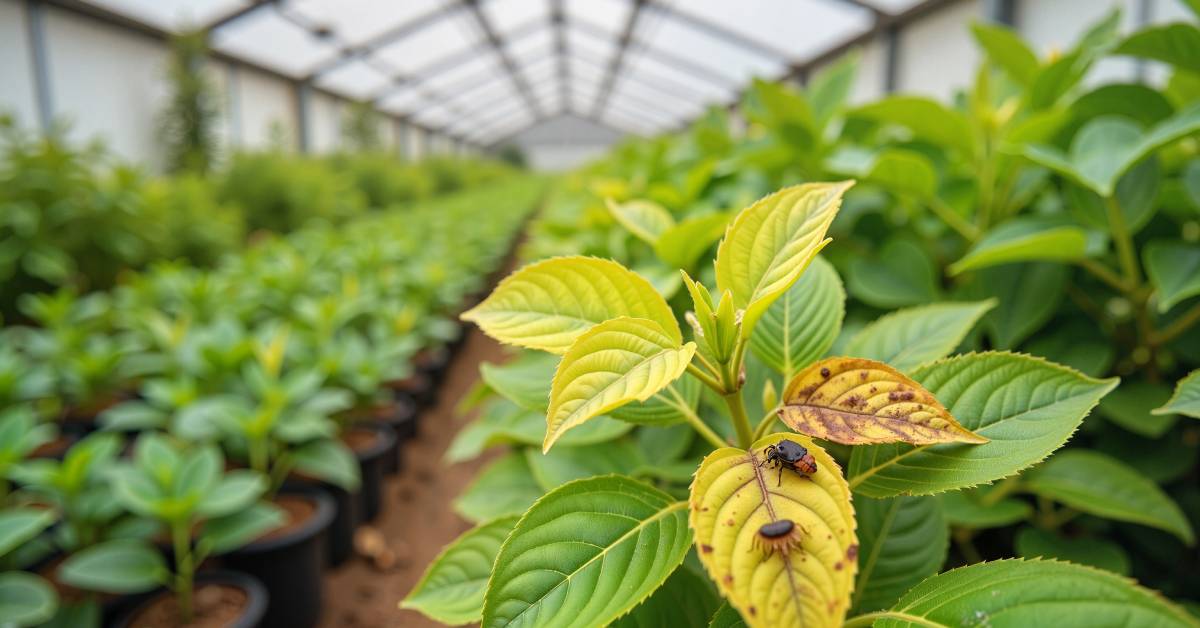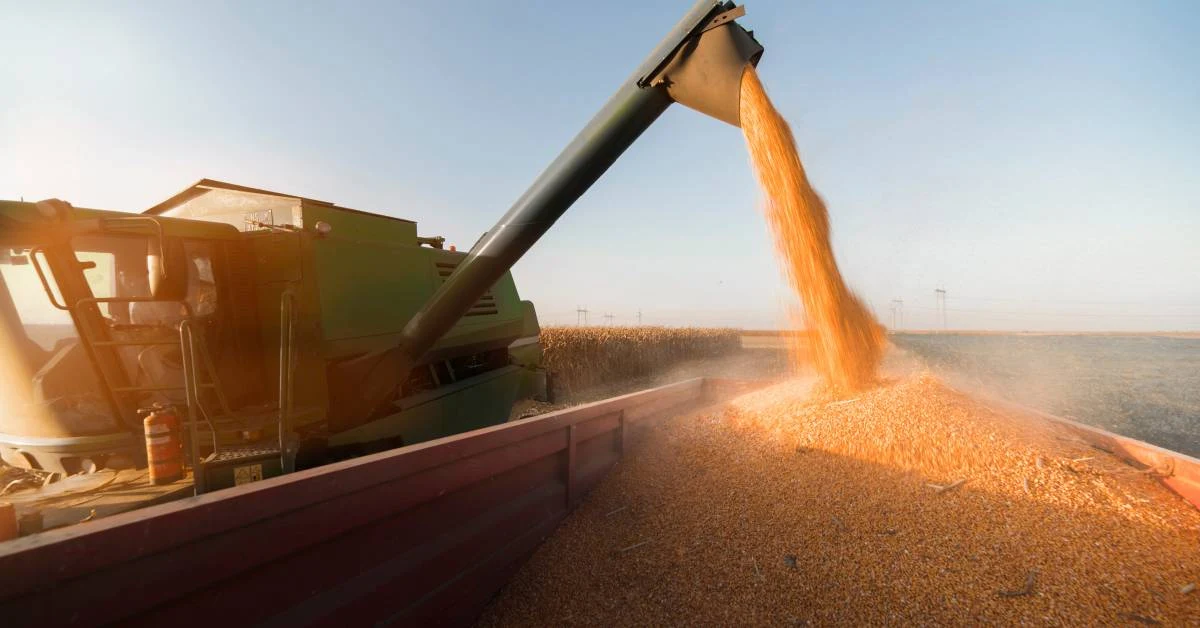Vapor Pressure Deficit, or VPD, is a key metric in controlled growing environments. It measures the difference between the moisture the air can hold at a given temperature and how much moisture is actually present. For growers practicing greenhouse farming or indoor farming systems, this difference plays a major role in how plants breathe, absorb nutrients, and grow.
Unlike monitoring temperature or humidity on their own, VPD provides a more complete view of plant health. It affects how open or closed the stomata are, which impacts both transpiration and carbon dioxide intake. When VPD is not balanced, plants often show signs of stress, poor growth, or even reduced yield.
Growers who understand how VPD works can adjust their climate settings more effectively. For example, a meta-analysis across 112 plant species found that rising VPD systematically decreases both crop and non-crop productivity, even under well-watered conditions. This helps avoid issues like mold, nutrient lockout, or inconsistent harvests. From propagation to flowering, VPD can guide better decision-making across the crop cycle.
This guide breaks down what vapor pressure deficit really means, how it’s calculated, its importance and how Folio3 AgTech makes it easier to monitor and manage VPD in real time, so growers can make smarter decisions, protect plant health, and maximize yields across every stage of production.
What Is Vapor Pressure Deficit (VPD)?
Vapor Pressure Deficit, or VPD, is a way to measure how much water vapor the air could hold versus how much it’s actually holding. In simple terms, it tells you how thirsty the air is. This matters because the drier the air (higher VPD), the more moisture it pulls from the plants through transpiration. When the air is too humid (low VPD), that process slows down, and plants can become stressed, prone to disease, or experience reduced nutrient uptake.
Vapor pressure deficit is closely tied to two major environmental factors: temperature and relative humidity. As temperature increases, air can hold more moisture. But if humidity doesn’t rise with it, the VPD climbs. This creates a strong pull on the plant’s internal moisture, sometimes more than the plant can keep up with.
It is not just another growth metric. It’s the result of a dynamic relationship between growing degrees and the environment around it. That’s why experienced growers use VPD to make better decisions about when to adjust their irrigation system, HVAC systems, lighting, and even airflow.
By understanding what vapor pressure deficit is and how it affects plant function, growers can reduce risk with this data management to improve crop yields and get more predictable results from season to season.
How to Calculate Vapor Pressure Deficit (VPD)
Understanding VPD starts with knowing how to calculate it within the controlled environment agriculture sector. Luckily, the math isn’t complicated once you break it down. You only need two things to get started: temperature and relative humidity (RH). These values help you determine how much moisture the air can hold and how much it’s currently holding. If you’re struggling with the calculations, working with a math tutor can make the process much easier and help build your confidence in applying these concepts.
Step 1: Calculate the Saturation Vapor Pressure (SVP)
This tells you the maximum amount of water vapor the air can hold at a specific temperature. The formula for SVP in pascals (Pa) is:
SVP = 610.78 × e^(T / (T + 237.3) × 17.2694)
Where:
- T = air temperature in °C
- e = Euler’s number (approximately 2.718)
To convert SVP to kilopascals (kPa), divide the result by 1,000.
Step 2: Calculate the Actual Vapor Pressure (AVP)
AVP reflects how much water vapor is actually in the air. You can calculate it using:
AVP = SVP × (RH / 100)
Step 3: Find the VPD
Now that you have SVP and AVP, subtract AVP from SVP:
VPD = SVP − AVP
This final number, in kilopascals, gives you the Vapor Pressure Deficit. The higher the number, the drier the air feels to plants.
What About The Leaf VPD?
Air VPD gives a general picture, but it doesn’t always reflect the conditions your plants are directly experiencing. That’s why advanced growers calculate Leaf VPD, which factors in the leaf temperature. Because leaves are often slightly cooler than the surrounding air, Leaf VPD is usually lower.
You’ll need an infrared thermometer or thermal camera to measure the leaf surface temperature. Drones in agriculture come handy for large farms which makes it easier for bulk temperature detection. The rest of the calculation follows the same steps, but you use leaf temperature instead of air temperature for SVP. Leaf VPD becomes especially important during heat waves, flowering stages, or when growers need precise humidity control to prevent plant stress or mold issues.
Why VPD Is Important in Plant Development
Vapor Pressure Deficit (VPD) is more than just a climate metric. It directly influences how plants function at a biological level. When you dial in the right VPD, you’re setting up your crops to breathe, feed, and grow efficiently.
VPD Regulates Stomatal Behavior
Stomata are tiny openings on the leaf surface that control gas exchange. They let in carbon dioxide (CO₂) and release oxygen and water vapor. When the vapor pressure deficit is too high, plants close their stomata to avoid losing too much moisture. This limits CO₂ intake, which slows down photosynthesis. On the other hand, when VPD is too low, plants may take in too much water, leading to poor nutrient uptake and mold issues.
The ideal VPD keeps the stomata slightly open. This encourages healthy transpiration while still supporting CO₂ absorption and nutrient transport.
Nutrient Uptake and Transpiration
Transpiration plays a key role in pulling nutrients from the roots to the leaves. As VPD increases within an optimal range, water evaporates faster through the leaves, creating a pressure difference that pulls more water and nutrients upward. If VPD is off, this process becomes inefficient. Low VPD may cause water to stagnate in the roots. High VPD can stress the plant and dry it out too quickly.
Impact on Growth Stages

Each growth stage has different VPD needs:
Seedlings and clones
Need lower VPD values. High humidity helps minimize stress while roots develop.
Vegetative phase
Plants thrive under moderate VPD. This encourages transpiration without stressing the leaves.
Flowering plants
Prefer slightly higher VPD. It reduces the risk of mold while supporting nutrient movement.
Night Phase
Although plants transpire far less at night, maintaining stable VPD levels during this phase is important. It helps prevent sudden humidity spikes, reduces disease risk, and supports consistent respiration and recovery.
Failing to adjust VPD as the crop matures can lead to stunted growth, delayed flowering, or inconsistent yields.
Stress Management
Plants that operate outside their optimal VPD range are more prone to stress. This stress weakens immunity, making them more vulnerable to diseases and pests. High-stress conditions also affect flavor, texture, and shelf life, especially in produce like lettuce, herbs, and tomatoes.
That’s why many commercial growers now treat VPD as a cornerstone metric and not just a side calculation. When managed properly, it leads to stronger plants, fewer losses, and better overall quality.
Ideal VPD Ranges for Each Growth Stage
| Growth Stage | Ideal VPD Range (kPa) | Notes |
| Seedlings & Clones | 0.4 – 0.8 | High humidity needed, fragile roots, avoid drying out |
| Vegetative Stage | 0.8 – 1.2 | Balanced transpiration, strong foliage and root growth |
| Flowering Stage | 1.2 – 1.5 | Lower humidity to avoid mold, support quality production |
| Night Phase | 0.8 – 1.2 | VPD should stay close to daytime levels to reduce swings and stress. |
Why This Matters
Adjusting vapor pressure deficit at every stage helps growers guide plant behavior. It’s like tuning an instrument, one wrong setting throws off the harmony. Get it right, and your plants will reward you with strong roots, steady growth, and reliable yields. Too high a VPD leads to excessive water loss. Leaves curl, growth slows, and the plant focuses more on surviving than producing. Too low, and you get sluggish transpiration, poor nutrient movement, and a higher risk of mold or mildew. Finding the right VPD “sweet spot” keeps plant stress low and productivity high.
Growers often aim for a VPD between 0.8 and 1.2 kPa, but the ideal number depends on the crop and its growth stage. For example, seedlings prefer lower VPD, while flowering plants can handle (and sometimes benefit from) higher levels.
Tools to Monitor Vapor Pressure Deficit Accurately
Monitoring vapor pressure deficit (VPD) in real time is essential for growers who want to stay ahead of plant stress and optimize conditions for each growth stage. The right tools not only track temperature and humidity but also help interpret data, send alerts, and suggest corrective actions. As AgTech continues to advance, modern greenhouses and indoor farms are using sensors and automation to manage VPD more precisely. Systems can now monitor both leaf and air temperatures, calculate real-time VPD, and trigger alerts or responses when conditions shift outside the target range. This level of control was once limited to lab environments. Now, it’s available to everyday growers, thanks to integrated technologies designed specifically for agriculture.
IoT-Enabled Sensors and Controllers
At the core of VPD monitoring are IoT sensors that track environmental variables like:
- Air temperature
- Relative humidity
- Leaf surface temperature
- CO₂ levels
These are typically installed across various zones in a grow facility. The data is transmitted wirelessly to a central controller or software dashboard. Multi-zone monitoring ensures that growers can manage microclimates within large or complex environments.
Mobile Apps and Grower Dashboards
Many growers now rely on apps and cloud-based dashboards that sync with their sensors and climate control systems. These tools display live data and VPD calculations, allowing for:
- Instant visibility into the grow environment
- Historical trend tracking
- Custom alerts when VPD deviates from ideal ranges
- Adjustments to HVAC, humidifiers, or dehumidifiers directly from the interface
Some platforms even allow remote access so growers can check in from anywhere and respond to issues without delay.
Data Logging and Predictive Analytics
Beyond real-time monitoring, top-tier tools provide logging capabilities and analytics features. This helps growers:
- Identify recurring VPD fluctuations
- Correlate VPD with yield performance
- Fine-tune conditions for each crop and growth phase
- Predict plant stress before symptoms appear
This kind of insight is especially important for high-value crops where consistency and quality drive margins.
How Folio3 AgTech Helps Growers Manage VPD
Folio3 AgTech provides a greenhouse management software that enables growers to monitor and maintain ideal vapor pressure deficit levels. Rather than juggling separate systems or relying on manual tracking, growers can use a unified platform that connects directly to their climate controls and sensors.
Key Features:
- Real-time VPD calculation across zones using temperature, humidity, and leaf surface data
- Automatic alerts when conditions fall outside optimal ranges
- Climate control suggestions based on crop type and growth stage
- Historical data tracking for long-term optimization
- Custom dashboards to monitor conditions by room, crop, or site
- Seamless integration with irrigation, HVAC, and inventory systems
- Secure, cloud-based access with team-level permissions
Folio3 AgTech turns environmental data into daily decision-making tools, helping greenhouse operators boost consistency, reduce stress on crops, and increase overall yields with precision.
Conclusion
Vapor pressure deficit is more than just a climate metric. It is a core indicator of plant health, hydration, and growth efficiency. When managed correctly, VPD helps growers strike the right balance between transpiration and stress, supporting stronger yields and healthier crops across every growth stage.
With tools that track, calculate, and respond to real-time environmental changes, AgTech is making vapor pressure deficit management more practical and accessible than ever. From sensors and analytics to automation and alerts, growers now have everything they need to keep conditions just right, both day and night.
If you’re aiming for consistent quality, faster cycles, and better use of resources, mastering VPD should be high on your list. And with Folio3 AgTech, it is not just possible. It is built into your system from day one.
FAQs
What Is A Good VPD?
A good VPD depends on the plant’s growth stage. For most crops, a range between 0.8 to 1.2 kPa is considered ideal. Seedlings thrive at the lower end to reduce stress, while flowering plants benefit from higher values to prevent mold and improve nutrient flow. Monitoring and adjusting VPD according to plant maturity is key for consistent yields.
What Happens When VPD Is Low?
When VPD is too low, the air becomes overly humid, slowing down transpiration. This can lead to poor nutrient uptake, weaker root pressure, and increased risk of fungal diseases. Plants may show signs of drooping or yellowing, and growth becomes sluggish due to the lack of moisture movement within the plant system.
Is VPD The Same As RH?
No, VPD and Relative Humidity (RH) are related but not the same. RH measures how much moisture is in the air as a percentage of its total capacity. VPD, on the other hand, measures the actual pressure difference between the current moisture level and the maximum the air can hold. VPD offers a more precise indicator of how plants experience their environment.
What VPD Causes Mold?
Mold typically forms when VPD is too low, usually below 0.4 kPa, as the air is too saturated with moisture. This creates conditions where condensation forms on plant surfaces, encouraging mold and mildew growth. Maintaining a VPD within optimal ranges helps prevent such pathogens and protects crop quality.







